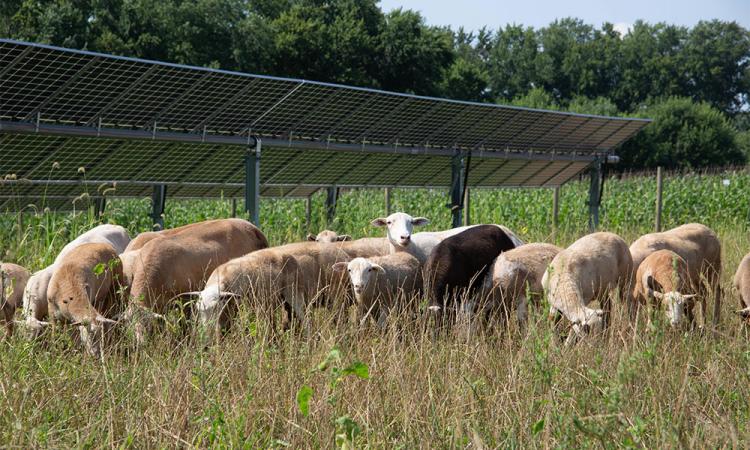"Solar grazing" avoids drops in solar panel efficiency due to vegetation shading and avoids the use of fossil fuels for mowing.
Madison Gas and Electric's (MGE) newest solar array, Tyto Solar in Fitchburg, is its first renewable project to use sheep to help control ground cover. About 70 sheep from nearby Wiscovery Farm arrived at the 6-megawatt (MW) solar facility in July. The grazing sheep help control ground cover during the growing season, maintaining grass and brush in a sustainable way.

This practice is an example of agrivoltaics or dual-use solar. The land is used for solar generation and agricultural production, such as crop or livestock production or the creation of pollinator habitat.
"Solar grazing" incorporates sheep farming at solar sites to keep the grasses from shading the solar panels. This avoids drops in panel efficiency due to vegetation shading the panels and avoids the use of fossil fuels for mowing.
"This is a great partnership around sustainability," said John Armstrong, MGE Manager Renewable Engineering. "We want to avoid any shade on the panels, and the sheep help us do that while also adding to the biodiversity of the site."
"Solar grazing is a proven concept in the United States, but it is new to the Midwest," said Beau Stafford, owner and operator of Wiscovery Farm and Wiscovery Grazing LLC. "Solar grazing is an innovative way forward for Wisconsin farmland. It allows us to preserve our rich agricultural heritage while investing in renewable energy infrastructure. It just takes forward-looking utility companies like MGE and farmer creativity to spark this mutually beneficial partnership."
Wiscovery Grazing LLC
Wiscovery Grazing LLC is a certified organic farm owned and operated by Beau and Grace Stafford of Fitchburg. As first-generation farmers, Beau and Grace and their two children bring a fresh approach and perspective to incorporating agriculture into Wisconsin's rapidly expanding solar industry. Their flock of registered Katahdin sheep will continue to graze at Tyto Solar through the growing season, which typically runs until mid to late October. After wintering at the nearby Wiscovery Farm, they will return to the Tyto Solar site in the spring for a second season of solar grazing.
- A flock of sheep from nearby Wiscovery Farm arrived at Tyto Solar in July.
- The sheep graze the site, helping control ground cover during the growing season, which usually runs through mid-October.
- "Solar grazing" maintains grass and brush in a sustainable way, which also avoids the use of fossil fuels for mowing.
- "Solar grazing" avoids drops in solar panel efficiency due to vegetation shading the panels.
- Wiscovery Farm is a certified organic farm with a flock of registered Katahdin sheep.
Another example of agrivoltaics is the creation of pollinator habitat at solar facilities. MGE has increased its pollinator-friendly habitat at other MGE-owned and MGE-operated solar generation sites by adding native plants.
Habitats that pollinators need to survive are shrinking, resulting in the loss of needed food and nesting sites. A pollinator is a bee, butterfly or other agent that transfers pollen from one plant to another. This enables fertilization and the production of food, such as berries, squash and walnuts.
MGE works with vegetation management consultants to make sure the plant mixes at the solar sites are viable in this climate and that they support pollinators from spring through fall. Developing a mature pollinator habitat typically takes three-to-five years to reach optimal condition. MGE's 22-MW O'Brien Solar Fields, which came online in 2021, is one of the company's most established pollinator sites. The first monarch caterpillars were spotted there in 2023. Pollinator habitat covers about 140 acres at the solar facility in Fitchburg.
Commitment to sustainability, carbon reductions
The practice of agrivoltaics is an example of MGE's commitment to advancing sustainability throughout its operations. The company is working toward net-zero carbon electricity by 2050.
Consistent with global climate science, carbon is MGE's target in mitigating the impacts of climate change. Under its commitments, by 2030, MGE expects to deliver MGE customers electricity with 80% fewer carbon emissions, and by 2050, the company expects to deliver net-zero carbon electricity.
Tyto Solar is one of several projects to help MGE achieve its industry-leading carbon reduction goals. More than 50 MW of additional cost-effective solar generation is expected to be added to MGE's energy supply mix by early 2025 with projects currently under construction. Learn more about MGE's existing and planned solar energy projects at mge.com/solar.
About MGE
MGE generates and distributes electricity to 163,000 customers in Dane County, Wis., and purchases and distributes natural gas to 176,000 customers in seven south-central and western Wisconsin counties. MGE's parent company is MGE Energy, Inc. The company's roots in the Madison area date back more than 150 years.
Media contact:
Steve Schultz - Corporate Communications Manager
Madison Gas and Electric
608-252-7219 | sbschultz@mge.com









